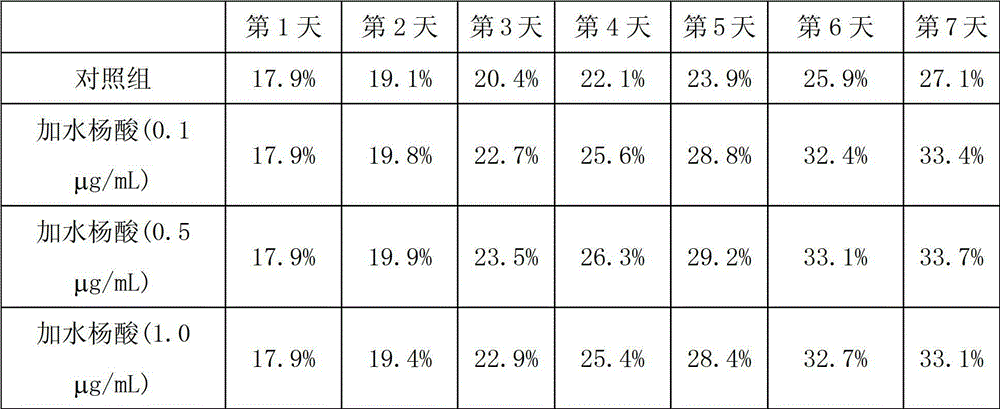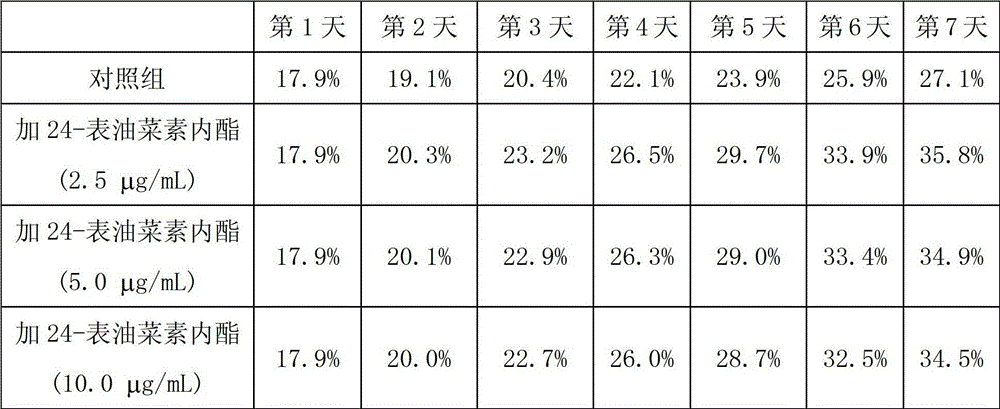Culturing method capable of promoting grease accumulation in chlorella
A technique for oil accumulation and cultivation method, which is applied in the field of cultivation that can promote oil accumulation in Chlorella, and achieves the effects of increasing oil content, improving growth and oil accumulation, and being inexpensive.
- Summary
- Abstract
- Description
- Claims
- Application Information
AI Technical Summary
Problems solved by technology
Method used
Image
Examples
Embodiment 1
[0018] The invention discloses a method for promoting oil accumulation of chlorella. First, the chlorella pyrenoidosa F-9 (C.pyrenoidosa) was quickly cultured to the late logarithmic growth period under better growth conditions, and the chlorella reached a higher density, and the OD was determined 460 =1.47. Fully dissolve chemically pure salicylic acid (SIGMA company) with a certain amount of ethanol to make a mother solution with a concentration of 1.0 mg / mL, and add the mother solution to the medium in the late logarithmic growth period, so that the final concentrations are 0.1, 0.5 , 1.0 μg / mL; the chlorella added with salicylic acid was continuously cultured at 25°C, with a light intensity of 4000lx, a photoperiod of 12 hours of continuous light and 12 hours of continuous darkness per day, and without the addition of exogenous medium. Daily detection of chlorella oil content (the detection method of chlorella oil is vanillin colorimetric method, the method refers to Cong...
Embodiment 2
[0022] It is basically the same as Example 1, except that the phytohormone uses 24-epibrassinolide (Shanghai Yuanye Biotechnology Co., Ltd.). After testing, the optimal final concentrations are 2.5, 5.0, and 10.0 μg / mL respectively. The obtained oil content accumulation data of Chlorella are shown in Table 2, and all the data are the average value of three determinations. Results The oil content of Chlorella added with 24-epibrassinolide was the highest at 35.8%, which was 132.1% of the control group.
[0023] Table 2 Changes in oil content in Chlorella after the control and the addition of 24-epibrassinolide (%)
[0024]
Embodiment 3
[0026] It is basically the same as in Example 1, except that the phytohormone uses salicylic acid (0.25 μg / mL final concentration in the culture medium) and 24-epibrassinolide (1.25 μg / mL) at the same time, and the obtained small The accumulation data of the oil content of the algae are shown in Table 3, and all the data are the average value of three measurements. Results The oil content of Chlorella added with salicylic acid and 24-epibrassinolide was 37.5%, which was 138.3% of the control group.
[0027] Table 3 Changes of oil content in chlorella after the control and adding two kinds of phytohormones (%)
[0028]
PUM
| Property | Measurement | Unit |
|---|---|---|
| concentration | aaaaa | aaaaa |
Abstract
Description
Claims
Application Information
 Login to View More
Login to View More - R&D
- Intellectual Property
- Life Sciences
- Materials
- Tech Scout
- Unparalleled Data Quality
- Higher Quality Content
- 60% Fewer Hallucinations
Browse by: Latest US Patents, China's latest patents, Technical Efficacy Thesaurus, Application Domain, Technology Topic, Popular Technical Reports.
© 2025 PatSnap. All rights reserved.Legal|Privacy policy|Modern Slavery Act Transparency Statement|Sitemap|About US| Contact US: help@patsnap.com



